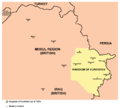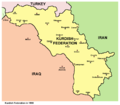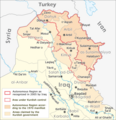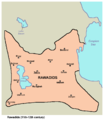List of Kurdish dynasties and countries
This is a list of Kurdish dynasties, countries and autonomous territories. By the 10th century, the term "Kurd" did not have an ethnic connotation and referred to Iranian nomads in the region between Lake Van and Lake Urmia.[1] In Arabic medieval sources, "Kurd" referred non-Persian and non-Turkish nomads and semi-nomads (see Origin of the Kurds).[2][3]
Early entities

- Sadakiyans (770-827)
- Aishanids (912–961)
- Daysam (938–955)[4]
- Hadhabanis (906–1080)
- Shaddadids (951–1199)[5]
- Rawadid dynasty (955–1071)[6]
- Hasanwayhids (959–1014)[7]
- Marwanids (983–1096)[5]
- Annazids (990/91[8][9]–1117)[10]
- Shabankara (1030-1425)[11][12][13]
- Principality of Eğil (1049–1864, Diyarbakir)[14]
- Khorshidi dynasty (1184-1597)[15]
- Principality of Bitlis (1187-1847)
- Hazaraspids (1115-1425)
- Ayyubid dynasty (1171–1341)[16]
- Vassaldom of Ardalan (14th century[17]–1865 or 1868[18][19])
- Emirate of Çemişgezek (13th century–1663)[20]
- Zakarids (1161-1360)[21][22][23]
- Mukriyan (14th century–19th century)[24]
- [25]
- Emirate of Pazooka (1499–1587)[26]
- Emirate of Soran (before 1514[27]–1836[28])
- [29]
- Principality of Suleyman[30] (15th century-1838)
Remnants of the Ayyubid Dynasty (13th century–19th century)
Various Kurdish political entities blossomed in the period after the disestablishment of the Ayyubid dynasty in 1260. Some of these rulers claimed descent from the Ayyubids.

- Principality of Donboli (1210–1799)[31]
- Emirate of Bingöl (1231–1864)[32]
- Emirate of Hasankeyf (1232[32]–1524[32])
- Emirate of Kilis[33]
- Emirate of Şirvan (?–1840s)[34]
- Emirate of Hakkâri (?–1845)[35]
- Emirate of Bahdinan (1339[36]–1843[37])
- Emirate of Bohtan (?–1833[37])
- Principality of Zirqan
- Principality of Mahmudi (1406–1839)[38]
- Principality of Pinyaşi (1548-1823)[39]
Buffer zones between the Ottomans and Persia (13th century–19th century)
For various reasons, Kurdish entities existed as buffer zones between the Ottoman Empire and Persia throughout history. These include:
- Emirate of Palu (1495–1845)[40]
- Emirate of Bradost (1510–1609)[41]
- Khoy Khanate (16th century–1805)[42]
- Baban (16th century–1850)[43]
- Hasan Khan dynasty in Pish-e Kuh (1795–1820)[44]
- Sarab Khanate (18th century)[45]
20th century entities
- Kingdom of Kurdistan (1921–1924 and 1925)
- Kurdistansky Uyezd (1923–1929) and Kurdistan Okrug (1930)
- (1992)[46]
- Republic of Ararat (1927–1931)
- Republic of Mahabad (1946–1947)

Provisions of the Treaty of Sèvres for an independent Kurdistan (in 1920)

Kingdom of Kurdistan in 1923

Red Kurdistan (1923–1929)

Republic of Mahabad, 1945-1946
Current entities
- Kurdistan Region (autonomous region in Iraq, 1970–)
- Autonomous Administration of North and East Syria (self-proclaimed autonomous region declared during the Syrian Civil War by the PYD) (2012–)

Iraqi Kurdistan in 1975

Iraqi Kurdistan in 1998

Iraqi Kurdistan in 2012

Modern Iraqi Kurdistan
Gallery

Khurasani Kurdish exclave circa 1835

Rawadid Dynasty

Marwanid Dynasty
See also
Bibliography
- Aboona, Hirmis (2008), Assyrians, Kurds, and Ottomans: Intercommunal Relations on the Periphery of the Ottoman Empire, Cambria Press, ISBN 9781604975833
- Baluken, Yusuf (2017), Çend Dokument ji Serdema Mîrektiya Melkîşî (in Kurdish), 7, Jimar
- Başçı, Veysel (2019), "Dunbulî Beyliği Tarihi ve Tarihi Kronikleri [XIII-XVIII. YY.]", Kadim Akademi SBD (in Turkish), 3 (2): 63–114, retrieved 28 May 2020
- Behn, W. (1988), "BĀBĀN", Encyclopedia Iranica, III, 3
- Büchner, V. F. (2012), "S̲h̲abānkāra", Encyclopaedia of Islam, BRILL, doi:10.1163/2214-871X_ei1_SIM_5253, ISBN 9789004082656
- Dehqan, Mustafa; Genç, Vural (2019), "The Kurdish Emirate of Brādōst, 1510-1609", Oriente Moderno, 99 (3): 306–320, doi:10.1163/22138617-12340222, retrieved 30 January 2021
- Ebraheem, Sharameen (2013), The Impact of Architectural Identity on Nation Branding: The Case Study of Iraqi Kurdistan. (PDF), Manchester Metropolitan University's Research Repository
- Eppel, Michael (2018), "The Kurdish emirates", Routledge Handbook on the Kurds, Routledge Handbooks Online, pp. 35–47, doi:10.4324/9781315627427-4, ISBN 978-1-138-64664-3, retrieved 1 May 2020
- Flynn, Thomas O. (2017), The Western Christian Presence in the Russias and Qājār Persia, c.1760–c.1870, BRILL, ISBN 9789004313545
- Ghalib, Sabah Abdullah (2011), The Emergence of Kurdism with Special Reference to the Three Kurdish Emirates within the Ottoman Empire, 1800-1850 (PDF), University of Exeter, retrieved 1 May 2020
- Gunter, Michael M. (2010), Historical Dictionary of the Kurds, Scarecrow Press, ISBN 9780810875074
- Hakan, Sinan (2002), Müküs Kürt Mirleri Tarihi ve Han Mahmud (in Turkish), Pêrî Yayınları, ISBN 9789758245581
- Kaplan, Yaşar (2015), Pınyanış Hükümeti/Government of Pinyanish (in Turkish), Hakkari University
- Maisel, Sebastian (2018), The Kurds: An Encyclopedia of Life, Culture, and Society, ABC-CLIO, ISBN 978-1-4408-4257-3
- Meinecke, Michael (1996), Patterns of Stylistic Changes in Islamic Architecture: Local Traditions Versus Migrating Artists, NYU Press, ISBN 9780814754924
- Petrushevsky, Ilya Pavlovich (1949), Очерки по истории феодальных отношений в Азербайджане и Армении в XVI-начале XIX вв (in Russian), Saint Petersburg State University
- Soyudoğan, Muhsin (2015), Tribal Bandistry in Ottoman Ayntab (1690-1730), Bilkent University
- Spuler, B. (2012), "Faḍlawayh", Encyclopaedia of Islam, BRILL, doi:10.1163/1573-3912_islam_SIM_2233, ISBN 9789004161214
- Top, Mehmet (1998), "Hoşaptaki Mahmudi Beylerine Ait Mimari Eserler", Academia SBD (in Turkish), 3 (2)
- Verheij, Jelle (30 March 2018), ""The year of the firman:" The 1895 massacres in Hizan and Şirvan (Bitlis vilayet)", Études arméniennes contemporaines (10): 125–159, doi:10.4000/eac.1495, ISSN 2269-5281, retrieved 24 May 2020
- Ünal, Mehmet Ali (1999), XVI. yüzyılda Çemişgezek sancağı (in Turkish)
References
- ^ van Bruinessen, Martin (1989). A. Andrews, Peter (ed.). "The ethnic identity of the Kurds". Ethnic Groups in the Republic of Turkey: 5.
- ^ Limbert, John (1968). "The Origins and Appearance of the Kurds in Pre-Islamic Iran". Iranian Studies. 1 (2): 48. doi:10.1080/00210866808701350. JSTOR 4309997 – via JSTOR.
- ^ James, Boris (September 2006). "Uses and Values of the Term Kurd in Arabic Medieval Literary Sources". Institut Kurde. Retrieved 4 April 2021.
- ^ "Welcome to Encyclopaedia Iranica".
- ^ Jump up to: a b Amir Hassanpour, Nationalism and Language in Kurdistan, 1918-1985, Mellen Research University Press, 1992, p. 50.
- ^ Jamie Stokes, Encyclopedia of the Peoples of Africa and the Middle East, Volume 1, Infobase Publishing, 2009, ISBN 978-0-8160-7158-6, p. 382.
- ^ Gunter (2010), p. 117.
- ^ Aḥmad, K. M. (1985). "ʿANNAZIDS". Iranica Online. II.
- ^ Pezeshk, Manouchehr; Negahban, Farzin (2008). "ʿAnnāzids". In Madelung, Wilferd; Daftary, Farhad (eds.). Encyclopaedia Islamica Online. Brill Online. ISSN 1875-9831.
- ^ Aḥmad, K. M. (1985). "ʿANNAZIDS". Iranica Online. II.
- ^ Büchner 2012.
- ^ Spuler 2012.
- ^ Pott, Daniel T. Nomadism in Iran: From Antiquity to the Modern Era. Oxford: Oxford University Press, 2014, 166; “The Shabankara (meaning “shepherd”) of easter Fars from other “Kurds.”… are thought to have been descendants of Daylamites or of some of the “Kurds” who were deported to Fars from the area of Isfahan…”
- ^ Han, Şeref (Çev. İbrahim Sunkur) (2016). Şerefname. Van: Sîtav. p. 204. ISBN 978-605-66520-1-1.
- ^ Spuler, B. (1987). "ATĀBAKĀN-E LORESTĀN". Encyclopedia Iranica. Retrieved 6 April 2021.
- ^ R. S. Humphreys, Ayyubids, "Encyclopaedia Iranica", (August 18, 2011),[1]
- ^ Oberling, P. "BANĪ ARDALĀN". Encyclopædia Iranica. Retrieved 2011-09-21.
- ^ David Mcdowall (1996). The Kurds (PDF). Minority Rights Group International Report. p. 20. Retrieved 2 May 2020.
- ^ Najat Abdulla-Ali (2006). Empire, frontière et tribu Le Kurdistan et le conflit de frontière turco-persan (1843-1932) (in French). p. 159.
- ^ Ünal (1999), pp. 262–263.
- ^ Alexei Lidov, 1991, The mural paintings of Akhtala, p. 14, Nauka Publishers, Central Dept. of Oriental Literature, University of Michigan, ISBN 5-02-017569-2, ISBN 978-5-02-017569-3, It is clear from the account of these Armenian historians that Ivane's great grandfather broke away from the Kurdish tribe of Babir
- ^ Vladimir Minorsky, 1953, Studies in Caucasian History, p. 102, CUP Archive, ISBN 0-521-05735-3, ISBN 978-0-521-05735-6, According to a tradition which has every reason to be true, their ancestors were Mesopotamian Kurds of the tribe (xel) Babirakan.
- ^ Richard Barrie Dobson, 2000, Encyclopedia of the Middle Ages: A-J, p. 107, Editions du Cerf, University of Michigan, ISBN 0-227-67931-8, ISBN 978-0-227-67931-9, under the Christianized Kurdish dynasty of Zak'arids they tried to re-establish nazarar system...
- ^ Hassanpour, Amir (1989). "BŪKĀN". Encyclopedia Iranica. IV.
- ^ Manoutchehr M. Eskandari-Qajar: Life at the Court of the Early Qajar Shahs, transl. and edit. from "Tarikh-e 'Azodi" by Soltan Ahmad Mirza 'Azod al-Dowleh, Mage Publishers, Washington 2014, pp. 140 ff.
- ^ Han, Şeref (Çev. İbrahim Sunkur) (2016). Şerefname. Van: Sîtav. p. 375. ISBN 978-605-66520-1-1.
- ^ Ghalib (2011), p. 50.
- ^ Ebraheem (2013), p. 235.
- ^ Hakan (2002).
- ^ Houtsma (1993), p. 1144-1445.
- ^ Başçı (2019), p. 63.
- ^ Jump up to: a b c Maisel (2018), p. 131.
- ^ Soyudoğan (2015).
- ^ Verheij (2018).
- ^ Flynn (2017), p. 663.
- ^ Aboona (2008), p. 175.
- ^ Jump up to: a b Eppel (2018), p. 42.
- ^ Top (1998), p. 6-9.
- ^ Kaplan (2015), p. 4.
- ^ Nusret Aydın, Diyarbakır and Mirdasiler History, 2011, p. 304-305
- ^ Dehqan & Genç (2019).
- ^ Petrushevsky (1949), p. 68.
- ^ Behn (1988).
- ^ Dehqn, Mustafa (2009). "Arkawāzī and His Baweyaļ: A Feylî Elegiac Verse from Piştiku". Iranian Studies. 42 (3): 409–422. doi:10.1080/00210860902907362. JSTOR 25597563. S2CID 159957313.
- ^ Tapper, Richard (2010). "Shahsevan". Encyclopedia Iranica.
- ^ Kemper, Michael; Conermann, Stephan (2011). The Heritage of Soviet Oriental Studies. Routledge. p. 92. ISBN 978-1-136-83854-5.
In 1992 the area of Laçin was occupied by Armeian forces; a "Kurdish Republic of Laçin" was subsequently declared by local Kurds, but this remained a rather short-lived - not to say stillborn - adventure
External links
- Kurdish dynasties
- Former Kurdish states
- Lists of former countries
- Former countries in Western Asia
- Kurdistan independence movement
- Lists of dynasties











